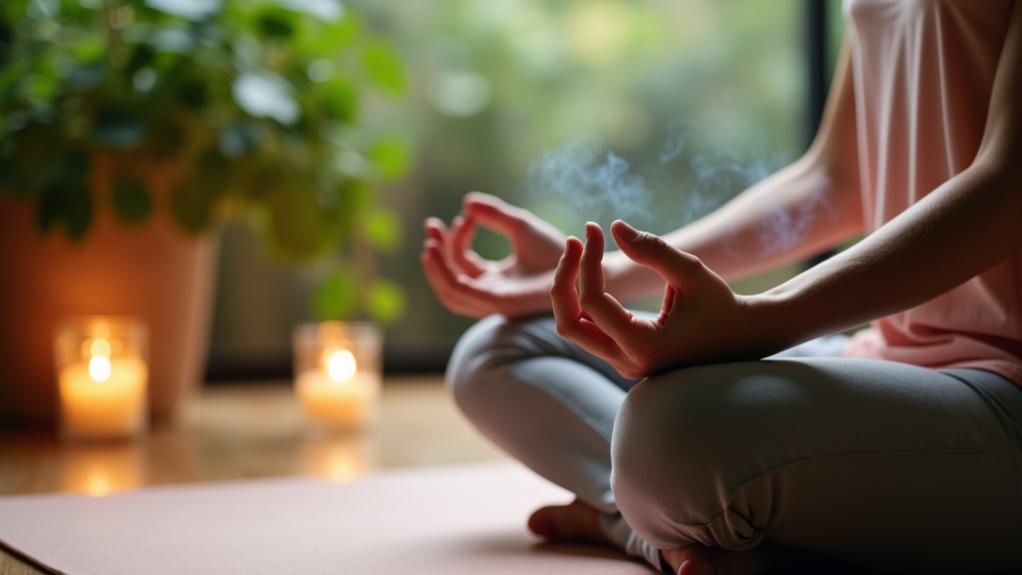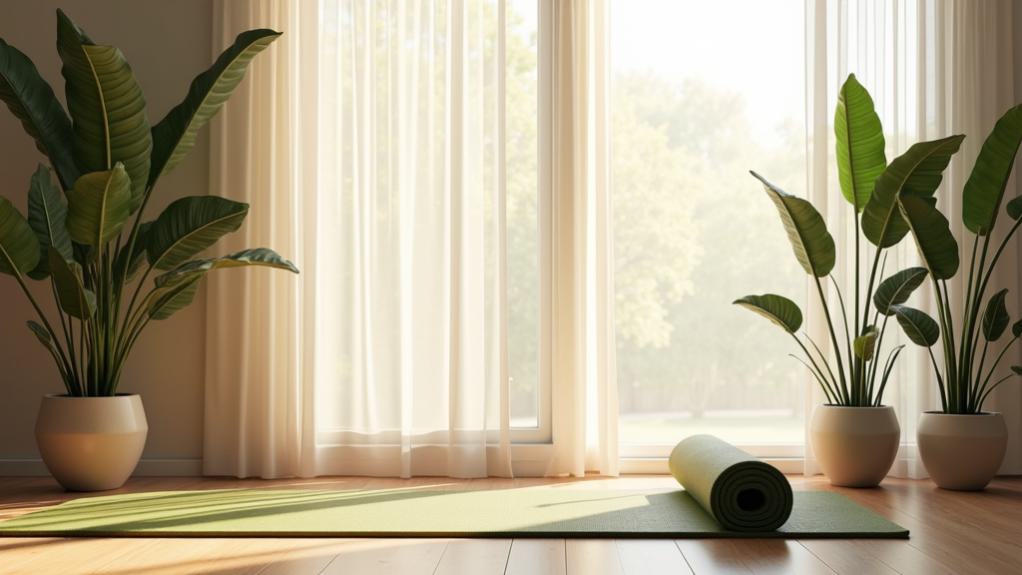Yoga’s a fantastic way to combat stress, and there are several key poses every woman should know. Start with Child’s Pose to release tension in your back, and try Legs-Up-the-Wall Pose to improve circulation and relaxation. The Standing Forward Fold stretches your hamstrings and calms your mind. Don’t forget the Bridge Pose to strengthen your body and boost mood. Incorporating focused breathing techniques, like diaphragmatic breathing, can enhance these benefits. Just a few minutes daily can uplift your spirit and emotional stability. Keep exploring these techniques to discover even more ways to soothe your mind and body.
Key Takeaways
- Child’s Pose: A gentle stretch that calms the mind and alleviates tension in the back and hips, ideal for stress relief.
- Legs-Up-the-Wall Pose: Promotes relaxation and improves circulation, helping to reduce anxiety and fatigue during stressful times.
- Standing Forward Fold: This pose stretches the hamstrings and back while encouraging a sense of grounding and release of pent-up stress.
- Bridge Pose: Strengthens the back and glutes, opening the chest and heart to foster emotional release and improve mood.
- Incorporate Breath Control: Use techniques like diaphragmatic breathing during poses to enhance relaxation and deepen the mind-body connection.
Overview of Stress Relief Yoga
Yoga for stress relief offers a powerful way to manage the pressures of daily life. This ancient practice promotes mindfulness and self-compassion, allowing you to reconnect with your body and mind.
By incorporating breathing techniques and meditation, yoga effectively reduces stress and anxiety. Research shows that regular yoga practice can markedly lower cortisol levels, the hormone linked to stress, enhancing your overall mental health.
Engaging in key poses, like Child’s Pose, Legs-Up-the-Wall Pose, and Corpse Pose, can bring immediate relief and promote relaxation. These poses create space for introspection and help calm your nervous system.
Just a few minutes of yoga each day can lead to substantial improvements in your mood and emotional stability.
As you practice, focus on deep breathing, which fosters a meditative state and enhances relaxation. This connection between breath and movement not only helps manage stress responses but also nurtures a sense of well-being.
Symptoms of Stress
Experiencing stress can manifest in various physical, mental, and emotional symptoms that affect your daily life. You might notice physical reactions like sweaty palms, a racing heart, or muscle tension. These symptoms can greatly impact your well-being and ability to function throughout the day.
Mentally, stress often leads to racing thoughts, irritability, and difficulty concentrating. This can result in decreased productivity and disrupt your emotional balance.
Emotionally, you may struggle with anxiety or even feelings of depression, which can overwhelm you and strain personal relationships. Chronic stress is particularly concerning, as it can lead to serious health issues such as high blood pressure, heart disease, and digestive problems.
Recognizing these signs is essential for effective stress management.
Top Yoga Poses

Incorporating specific yoga poses into your routine can greatly alleviate stress and promote relaxation. One of the most effective poses is Child’s Pose (Balasana), which stretches your back and hips while calming your nervous system. You can hold this pose for up to 5 minutes to enhance its stress-relief benefits.
Next, try the Legs-Up-the-Wall Pose (Viparita Karani). This restorative pose improves blood circulation and can be held for 5 to 15 minutes to reduce tension and foster a sense of calm.
The Standing Forward Fold (Uttanasana) is another great option, stretching your hamstrings and back to promote relaxation. Hold this pose for up to 1 minute to maximize its calming effects.
Bridge Pose (Setu Bandha Sarvangasana) strengthens your back and glutes while opening your chest, which can help reduce anxiety; hold it for 30 seconds to 1 minute.
Benefits of Regular Practice
Regular yoga practice can greatly boost your emotional stability, helping you handle stress more effectively.
You’ll likely notice improved sleep quality as well, allowing you to wake up refreshed and ready to tackle the day.
Embracing these benefits can lead to a more balanced and fulfilling life.
Enhanced Emotional Stability
Yoga offers a powerful pathway to enhanced emotional stability by cultivating mindfulness and self-awareness. When you practice yoga regularly, you’re not just stretching your body; you’re also nurturing your mind. This practice helps you manage your thoughts and feelings more effectively, fostering a sense of calm amidst life’s chaos.
As you engage in yoga, your body increases the production of endorphins and serotonin, hormones closely linked to improved mood and emotional well-being. This boost can greatly alleviate feelings of anxiety and stress, making it easier for you to cope with daily challenges.
Studies show that regular participants in yoga report fewer emotional fluctuations, leading to a more balanced emotional state.
Additionally, yoga enhances your self-awareness, allowing you to recognize emotional triggers and respond with greater composure and resilience. Over time, this practice can reduce symptoms of depression and anxiety, contributing to lasting emotional stability and overall mental health.
Improved Sleep Quality
Transforming your sleep quality can be as simple as adding a few mindful movements to your evening routine. Regular yoga practice promotes relaxation and helps reduce stress hormones, leading to a more restful night’s sleep.
Studies show that those who incorporate yoga experience markedly improved sleep quality and reduced insomnia symptoms.
To enhance your evening routine, consider these restorative poses:
- Child’s Pose: This gentle stretch calms the mind and releases tension from the body. It’s a perfect way to signal to your brain that it’s time to unwind.
- Legs-Up-the-Wall Pose: This pose encourages relaxation by returning blood flow to the heart and calming the nervous system, making it easier for you to drift off.
- Breathing Exercises: Pair your poses with deep, intentional breathing to further promote emotional regulation and stress management.
Importance of Breath Control

Breath control is a powerful tool in your yoga practice that can enhance relaxation and deepen your mind-body connection.
By focusing on your breath, you not only improve your focus and mental clarity but also create a calming effect that reduces stress.
Incorporating breath awareness into your routine can transform your experience and help you manage life’s challenges with greater ease.
Enhancing Relaxation Techniques
Mastering breath control can greatly enhance your relaxation techniques and overall stress management. By focusing on your breath, you can activate your parasympathetic nervous system, promoting calmness and reducing cortisol levels associated with stress.
Implementing deep breathing techniques in your daily routine can improve emotional regulation and resilience, making it easier to handle life’s challenges.
Here are three effective methods to incorporate breath control into your practice:
- Diaphragmatic Breathing: This technique involves breathing deeply into your diaphragm rather than shallowly into your chest. It encourages relaxation and lowers heart rates.
- 4-7-8 Technique: Inhale for a count of 4, hold for 7, and exhale for 8. This pattern stimulates relaxation and can be especially helpful during stressful moments.
- Mindful Breathing: Anchor your mind in the present by focusing on each breath. This practice fosters mindfulness, reducing reactivity to stressors.
Deepening Mind-Body Connection
Building on your relaxation techniques, deepening your mind-body connection is vital for enhancing your yoga practice. Breath control, or pranayama, plays an important role in this process. By focusing on deep breathing, you promote relaxation and greatly reduce stress levels during your sessions.
As you engage in controlled breathing, you not only calm your mind but also create a meditative state that enhances mental clarity. Studies show that these breath control techniques can lower your heart rate and decrease cortisol levels, aiding in effective stress management.
When you bring awareness to your breath, you foster a deeper connection between your body and mind, keeping you present and centered. This connection helps you navigate daily challenges with greater resilience to stress.
Moreover, practicing breath control improves your respiratory function, which is linked to better physical health. Incorporating breath awareness into your yoga routine enriches your overall experience, allowing for more profound relaxation and deeper meditation.
As you deepen your breath, you’ll find your yoga practice more fulfilling, leading to lasting stress relief and a strengthened mind-body connection.
Improving Focus and Clarity
When you harness the power of pranayama, you’ll notice a considerable boost in your focus and mental clarity during yoga practice.
Breath control, central to yoga, enhances oxygen flow to your brain, sharpening your cognitive performance and helping you achieve stress relief. By engaging in deep breathing, you not only lower cortisol levels but also cultivate resilience to stress.
To improve your focus and clarity, consider these three practices:
- Incorporate Deep Breathing: Use techniques like diaphragmatic breathing to calm your mind and alleviate anxiety.
- Practice Present-Moment Focus: Concentrate on your breath during yoga poses. This awareness quiets racing thoughts, allowing you to be fully present.
- Make Breath Control a Priority: As you master breath control, you’ll notice an increase in attention span, enabling better decision-making during stressful situations.
As you integrate these techniques into your practice, you’ll find that your mental clarity and ability to concentrate enhance considerably.
Embrace pranayama, and watch how it transforms not just your yoga sessions, but your everyday life.
Tips for Effective Practice
To get the most out of your yoga practice for stress relief, it’s essential to focus on a few key elements that enhance your experience.
Start with breath control; practicing deep breathing during each pose calms your nervous system and reduces stress levels. Incorporate mindfulness techniques by tuning into your body sensations and thoughts, which promotes presence and minimizes anxiety.
As you progress, remember to take gradual steps through the poses. Listen to your body and don’t hesitate to modify poses when needed. Using props like blocks or bolsters can enhance your comfort and alignment, making your practice more effective.
Consistency is key! Establish a regular practice schedule, as this has been proven to improve emotional regulation and mental clarity over time.
Conclusion
Incorporating yoga into your routine is like finding an anchor in a stormy sea. By practicing the recommended poses and focusing on your breath, you can calm the chaos of stress and regain your balance. Remember, it’s not just about the poses; it’s about creating a space for yourself to unwind and reconnect. So roll out your mat, breathe deeply, and let each session guide you toward a more peaceful, centered version of yourself.
Join our list
Subscribe to our mailing list and get interesting stuff and updates to your email inbox.

